#Occupy Oakland's general strike: A photo essay
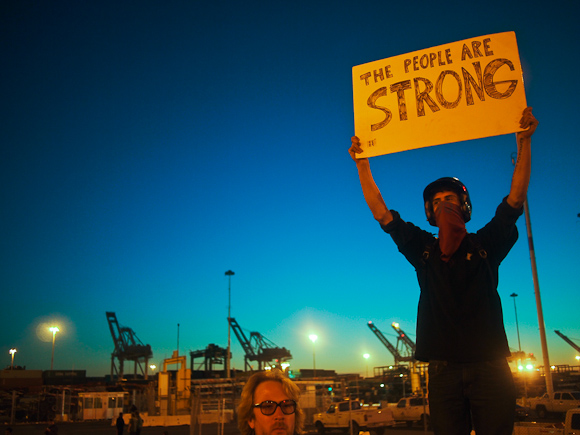
[See also Isaac Steiner's "live blog" of the November 2 general strike, which closed the Oakland port and banks. For more reports on the Occupy movement, click HERE.]
By Isaac Steiner
November 2, 2011, 11.45 pm – Solidarity Webzine – I'll end the day with some thoughts on the significance of the day. The general strike and national solidarity actions, built in under a week and with the severe deficit of practical knowledge in the tactic that's to be expected after a drought of over 60 years, has to be judged a success. That said, it didn't literally "shut the city down" – although there were glimpses of the possibility, especially in the case of some schools that reported near total absenteeism. In raw numbers, it didn't match the giant "Immigrant Spring" of 2006.
But the impact of this day on political consciousness and sense of the possible, in the United States and internationally, is enormous. Two months ago, it was unthinkable that there would be an open-ended protest organised around class polarisation encamped in downtown Oakland. One month ago, it was unthinkable that the infant Occupation would muster a general assembly of 2000 – much less overwhelmingly pass an ambitious call for a general strike. One week ago, it was unthinkable that this call would be met with success.
Like the occupations themselves, the general strike did not necessarily need a clear demand to make its goal clear (there were, in fact, demands). It was about the right to assemble and practice the novel form of organisation used at this stage of the movement – securing and defending the democratic right upon which greater rights can be won. That right has been secured. It would seem that the failure of New York City to clear Zucotti Park and the failure of Oakland to prevent the retaking of Oscar Grant Plaza are two major tactical blunders on the part of the ruling class. The potential to crush and demoralise the occupations while they were in a relatively immature phase was lost.
The Occupy movement as a whole has won a tremendous victory in reframing politics in the United States – identifying (or maybe revealing and naming) an enemy for the millions to target; trumping small "interest group" political logic with the empowering framework of a working-class super majority, and linking this political vocabulary with similar ruptures internationally, each of which have primarily targeted their own ruling class. The Oakland general strike has introduced a new element – acting on the special social power of the working class to stop production, rather than just our numerical strength.
It was also the most successful example yet of bridging the physical occupation site with a mobilisation of its widespread support in the city. A common feature of most city square occupations and the Wisconsin State Capitol occupation in the Spring is a "fetishisation" of the physical occupation as a utopian space – ignoring its role as a symbol, motor for broader social forces outside the occupation itself, and potential organising centre for those forces. The general strike balanced this dynamic – recognising the irreplaceable political role of the occupation (at this point) while not sucking all activity into maintaining the occupation.
As a strategic orientation begins to develop, political differences will become more clear. Judging by some thing I've observed today and at other occupations, these differences may initially sprout from tactics-elevated-to-strategy (like "pacifists" vs "anti-pacifists" -- which both treat the use, or abstention from using, physical force as some kind of holy principle). A broad movement will have both present, will be led by neither, and would make tactical choices that include "property destruction" as a means to an end (for example, mass squatting or workplace occupation).
Occupy Oakland is also, by far, the most multiracial and multinational Occupy I've seen yet (although not representative of the working class of the city). There are surely lessons in how to advance beyond "representational" and symbolic approaches to building an anti-racist movement into truly linking with, incorporating and strengthening movements that are already taking up issues of institutional racism.
In the short term, the main task for Oakland will be evaluating the successes and weaknesses of the strike effort, bringing in new leaders, and identifying a medium-term strategy for expanding the Occupy movement in the city. For the time being, Oakland make take a leadership role nationally, in the way that New York has provided. Whatever happens, the terrain is much more favorable for our side than it was just a week ago [continue reading Isaac Steiner's "live blog" HERE].* * *
On November 2, tens of thousands of people participated in the first general strike in 65 years as parts of Oakland were shut down in solidarity with the Occupy movement. Protesters were spurred to action by the brutal repression and attempted eviction of the Occupy Oakland encampment the previous week, and quickly mobilised to retake the space and escalate the struggle.
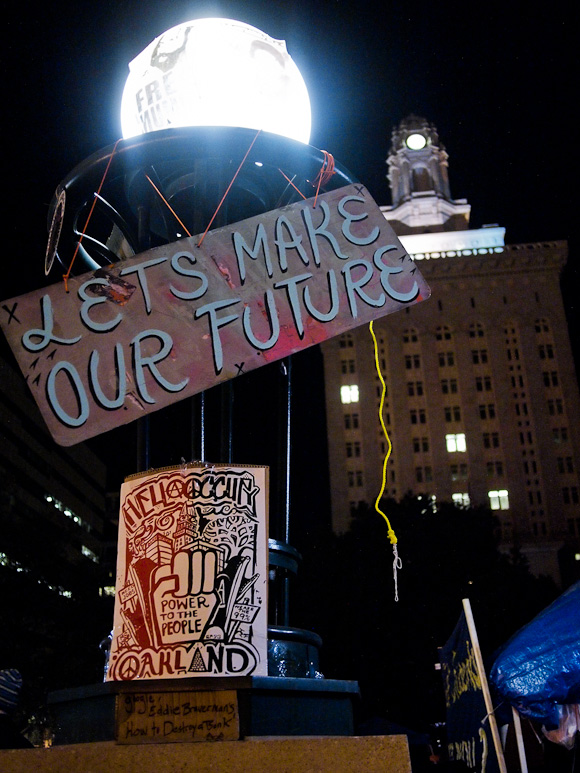
The night before: much of Occupy Oakland was quiet on Tuesday night, November 1,
as activists busied themselves finishing the plans, outreach, and
banners for Wednesday's general strike.
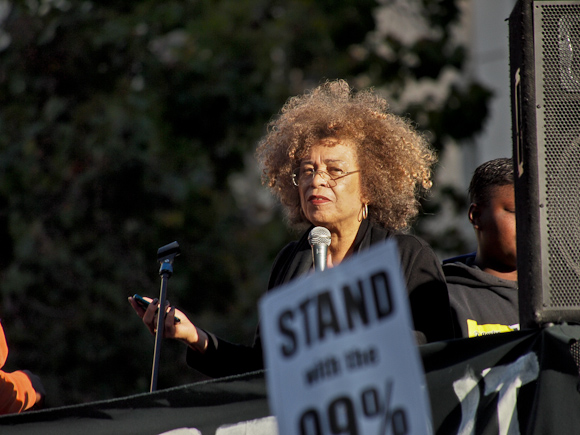
Angela Davis addresses the early morning rally at the intersection of 12th Street and Broadway in downtown Oakland, bringing reports and solidarity from her recent visits to Occupy demonstrations in New York City and Philadelphia.
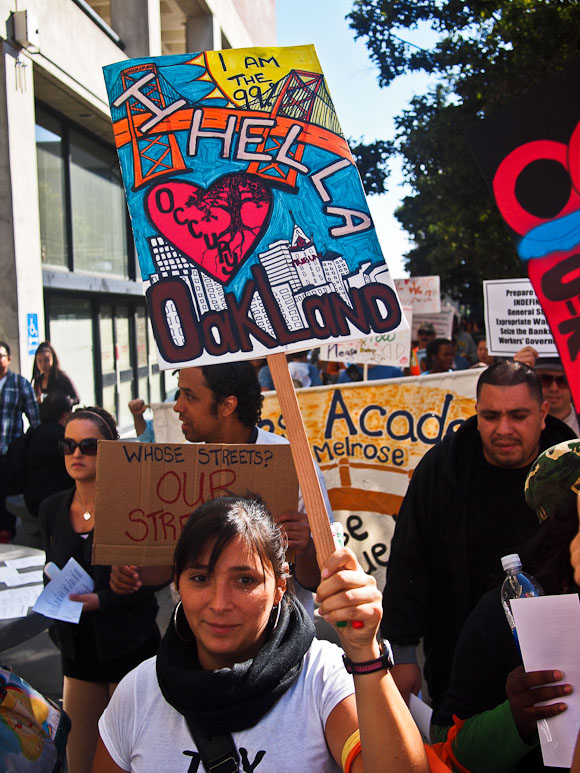
Students rally at Laney College for a public education feeder march to make demands around maintaining and expanding access to primary and higher education.
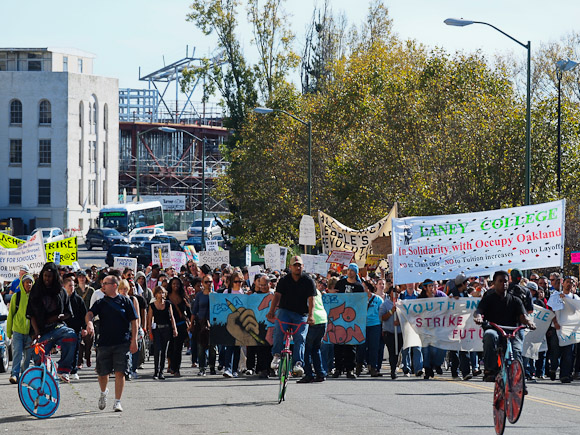
The education feeder march follows a crew of "scraper" bikes as it leads a brief rally on the steps of the Oakland Unified School District headquarters.
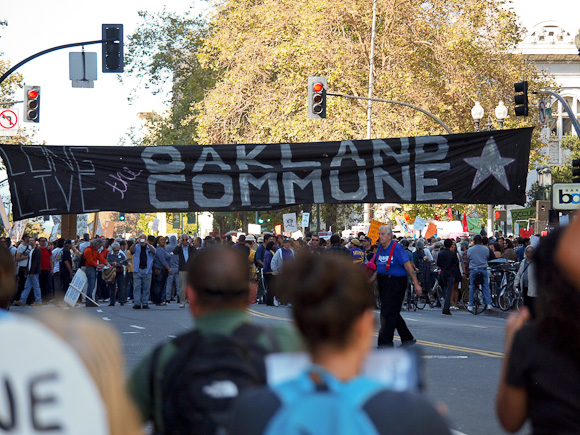
A large black banner welcoming strikers to the "Oakland Commune" hung across 12th Street.
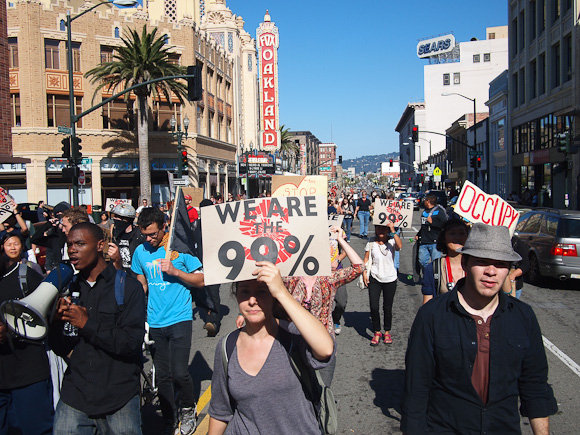
The UC Berkeley feeder march concludes its several miles long route to meet up with Occupy Oakland.
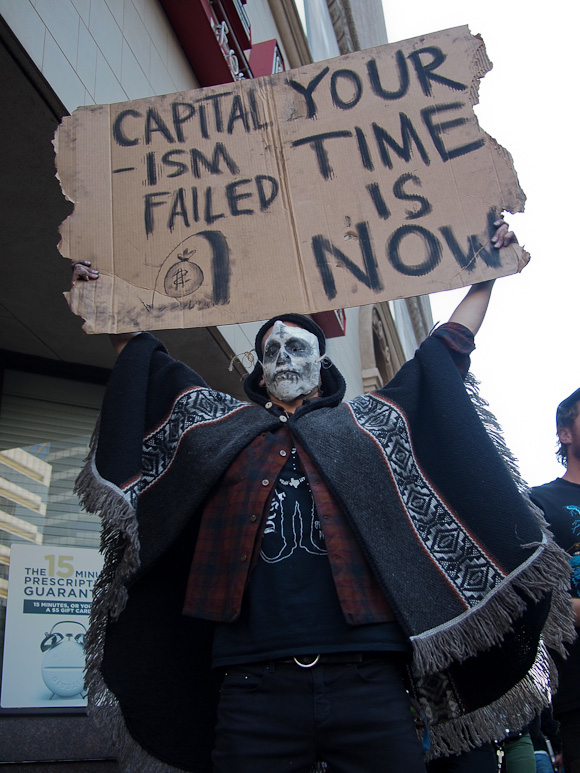
A demonstrator in Oscar Grant Plaza recognises Dia de los Muertos with a call to bury the capitalist system.
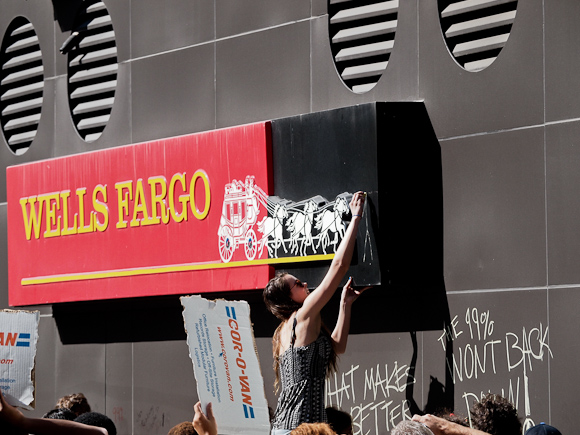
Protesters write slogans on a closed Wells Fargo bank with chalk. Practically all major banks in the downtown Oakland area were closed for the day.
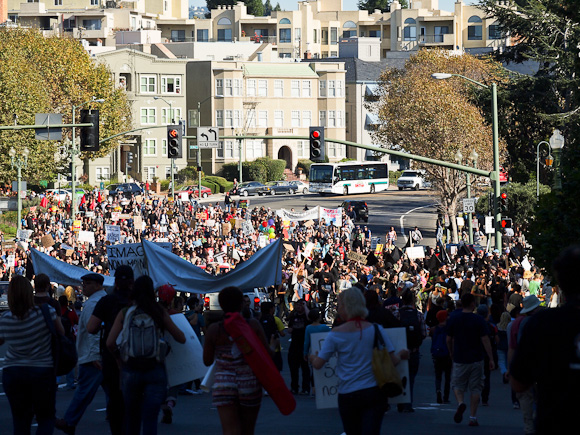
An anti-capitalist march rounds the corner of Harrison Street near Lake Merrit, en route to the Bank of America offices.
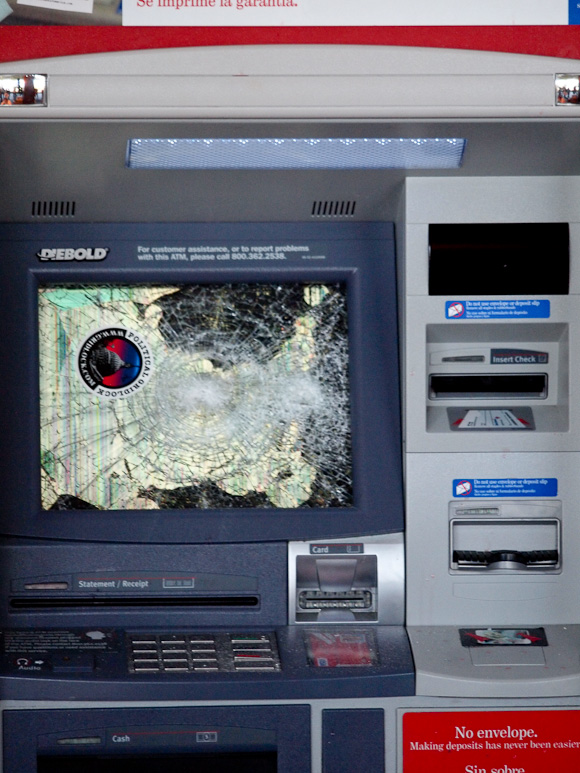
ATM out of order. Members of a "black bloc" and others engaged in targeted property destruction at several banks in the area, igniting tactical debates within the march.
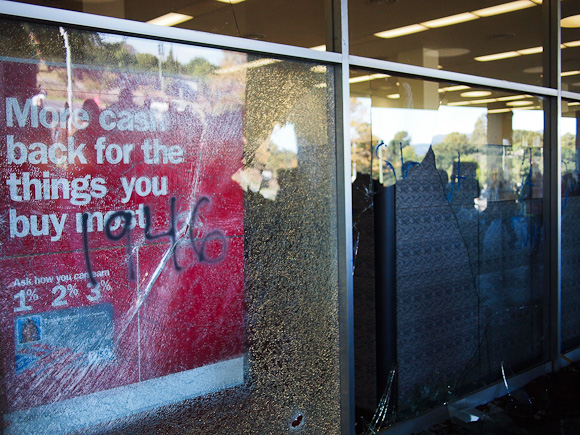
The spirit of '46: spraypainted numbers recall the last year workers walked out in a general strike in the United States – coincidentally, also in Oakland.
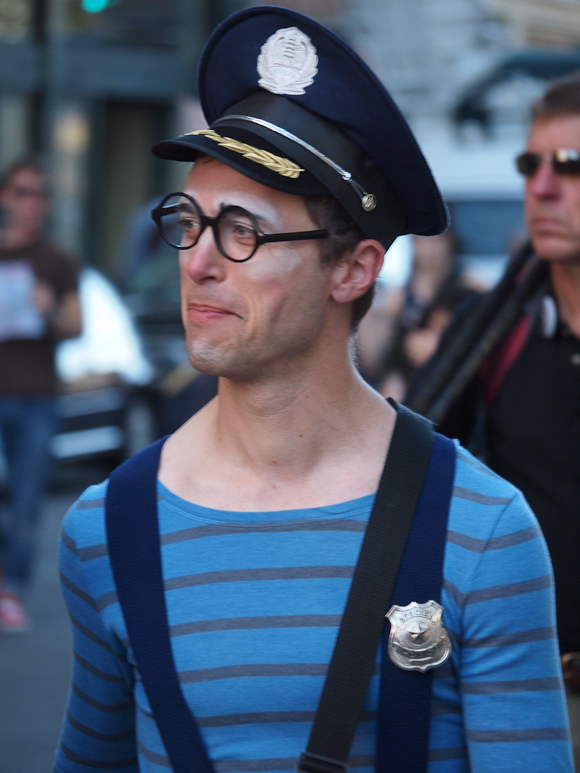
Dressed as a clownish police officer, one protester simultaneously mocked the cops and provided directions to the crowd (with a dash of the "confusion" expressed in a Open Letter from the Oakland Police Officers Association.
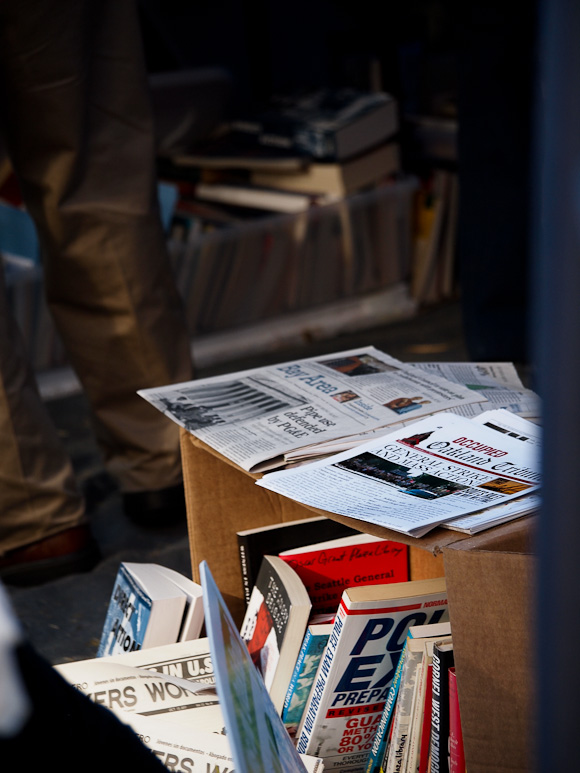
In the Oscar Grant Lending Library, fresh copies of the Occupied Oakland Tribune announce the general strike and mass actions of the day.
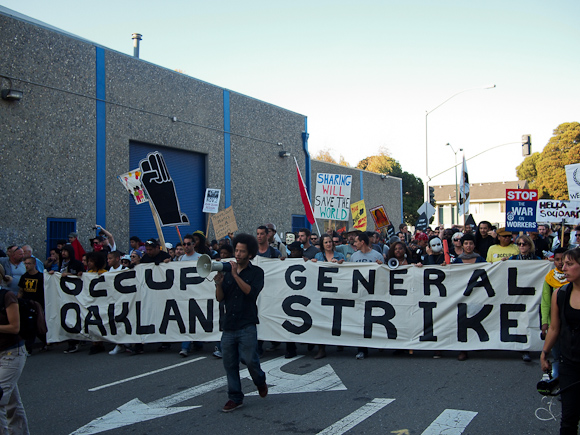
Rapper and political activist Boots Riley leads a march from Oscar Grant Plaza to the Port of Oakland, where demonstrators intended to shut down operations for the night shift.
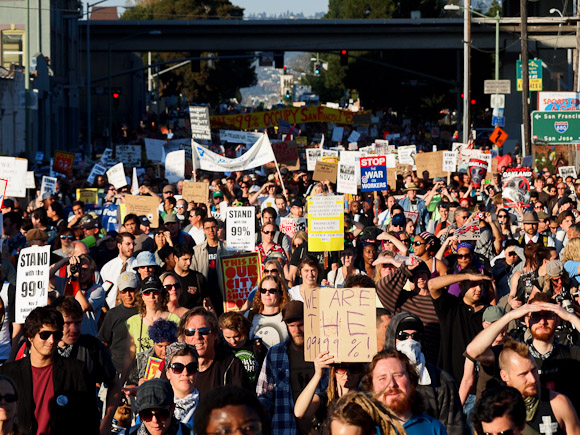
From across the bay, a contingent from Occupy San Francisco can be seen in the distance behind their banner reading: We are the 99% – Somos el 99%!
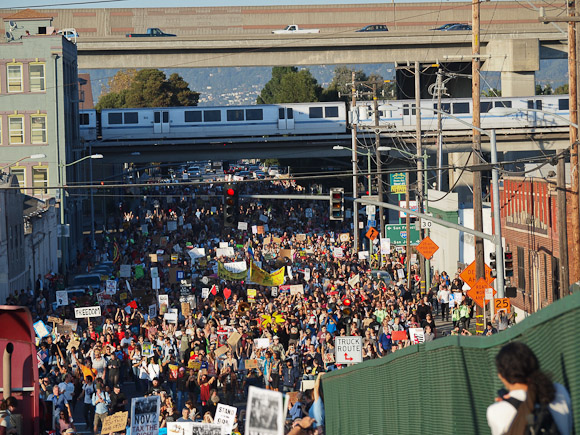
Waves of marchers filled Adeline Street on their way to the Port of Oakland.
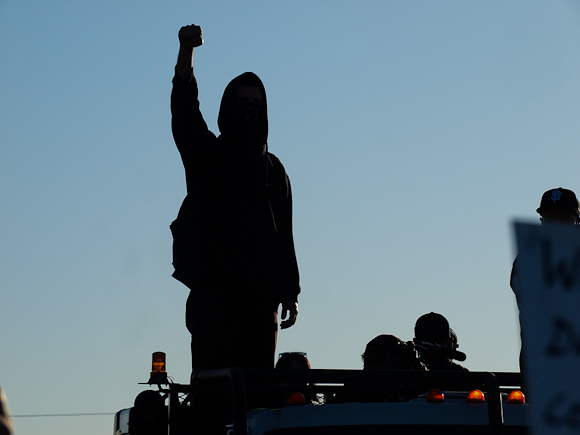
A hooded protester raises a fist from the roof of a cargo truck.
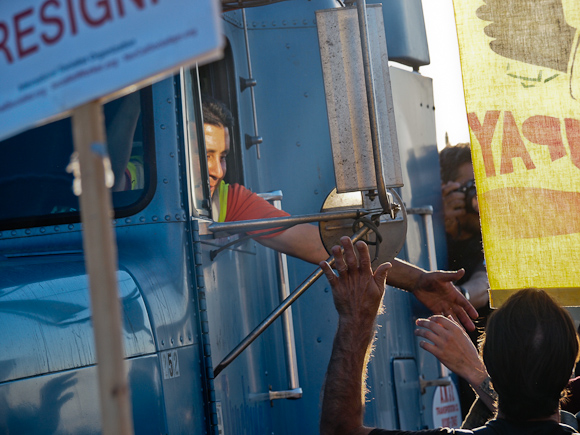
The driver of a port cargo truck greets demonstrators as they arrive to shut down the port.
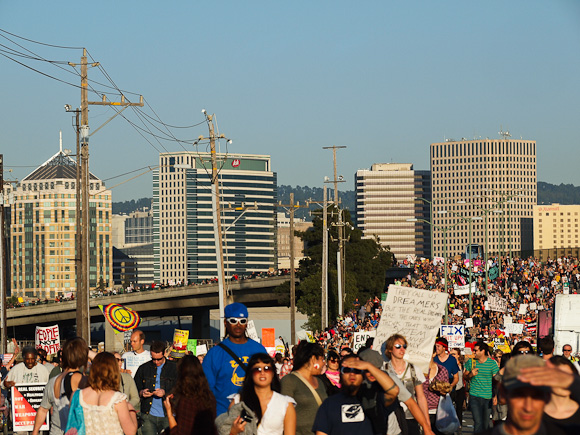
More and more marchers round the bridge entrance to the Port of Oakland. Estimates ranged from 15,000 up.
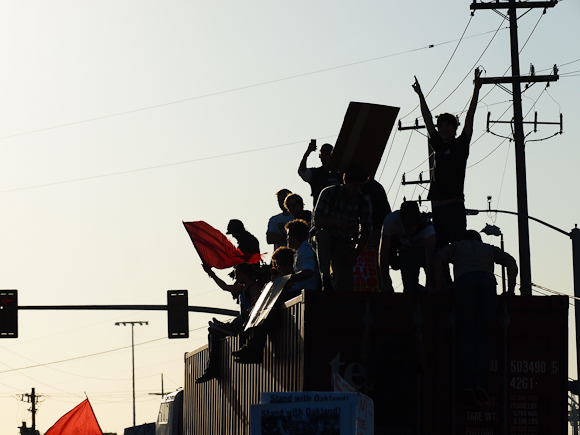
Raising the "victory" sign and waving red flags, protesters get a look at the march from the roof of a cargo truck.
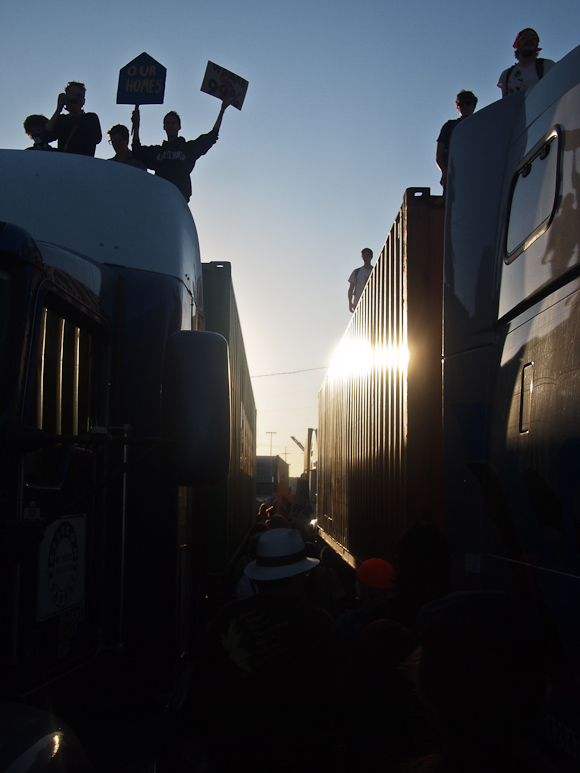
Parts of the march snaked through parked trucks in the roads of the port.
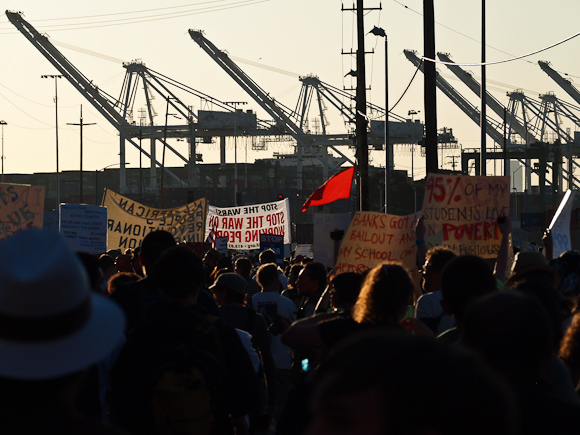
Approaching the cranes, demonstrators prepare to set up pickets at each port terminal to create conditions that would prevent the port's night workers from reporting for their shift.
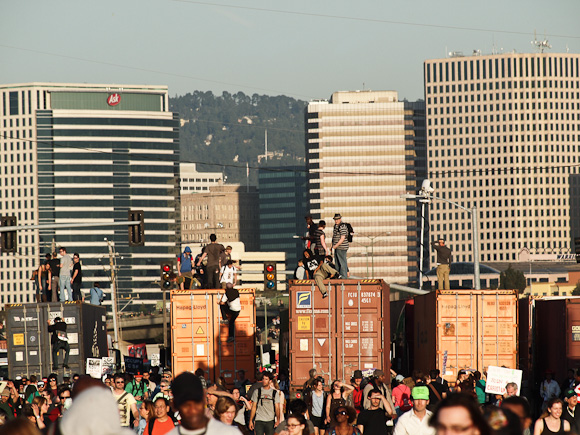
Downtown Oakland's skyscrapers that tower over a second march leaving Oscar Grant Plaza fill in the background behind the sea of demonstrators already at the port.
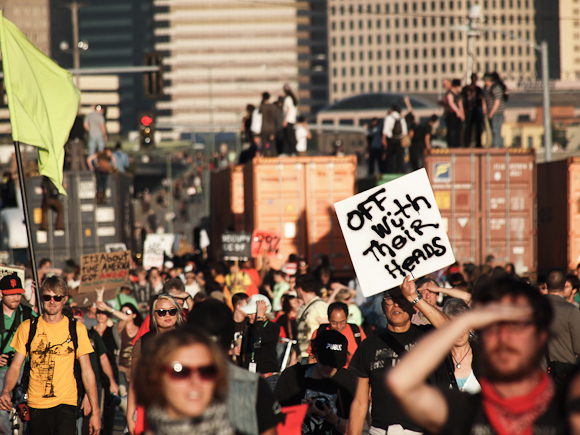
Off with their heads!
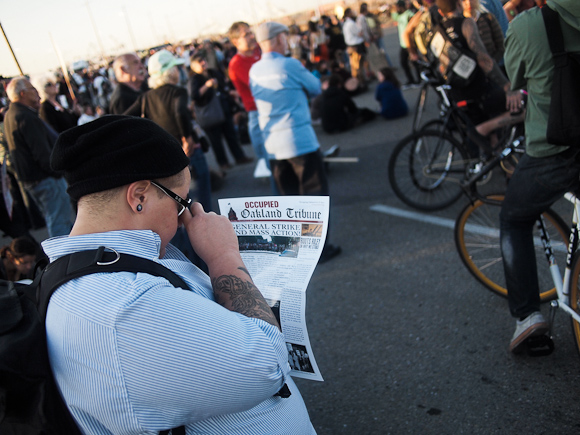
A demonstrator reads The Occupied Oakland Tribune broadsheet newspaper in the evening's fading light.
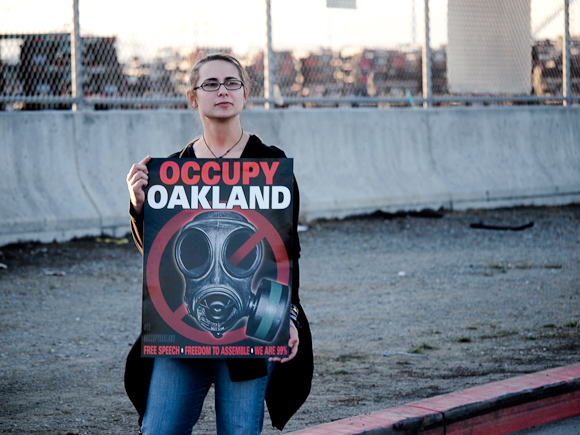
During the day, artists and printers distributed a variety of creative placards to demonstrators.
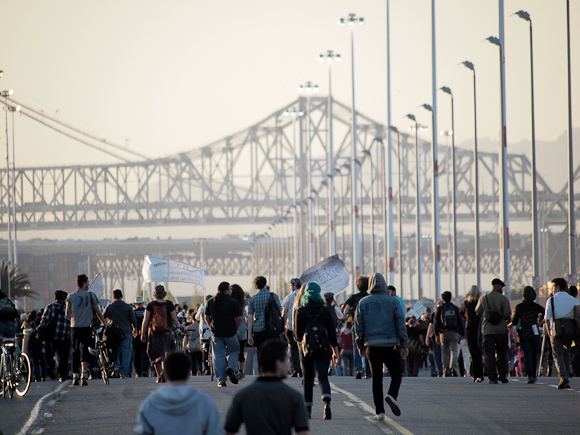
With the Bay Bridge before them, contingents of the march continue on to plug the port terminals further into the bay

The sun sets behind the cranes of the Port of Oakland as the scheduled night shift approaches.
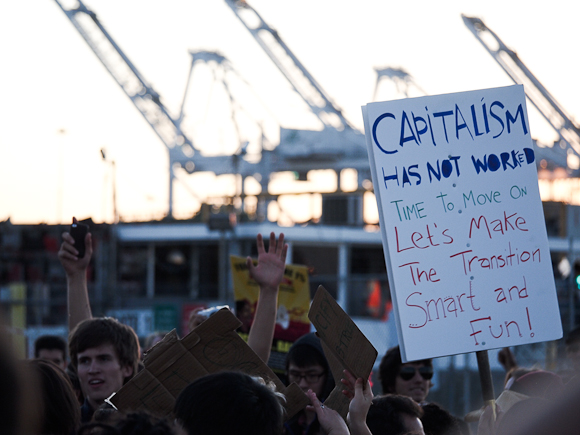
Protesters wave their hands and signs during a brass band dance party at one picket line.
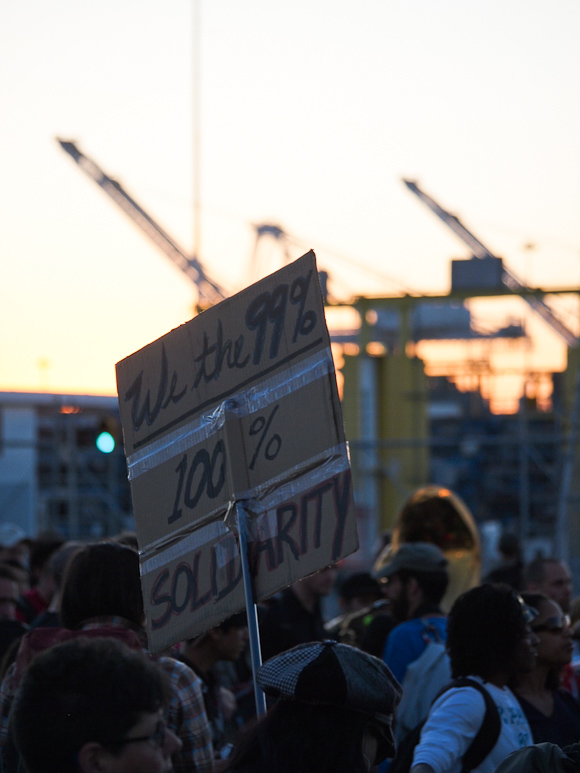
We the 99% - 100% Solidarity.

A masked protester holds a sign reading "The people are strong".

At an impromptu general assembly, picketers hear updates on the status of the port shutdown.
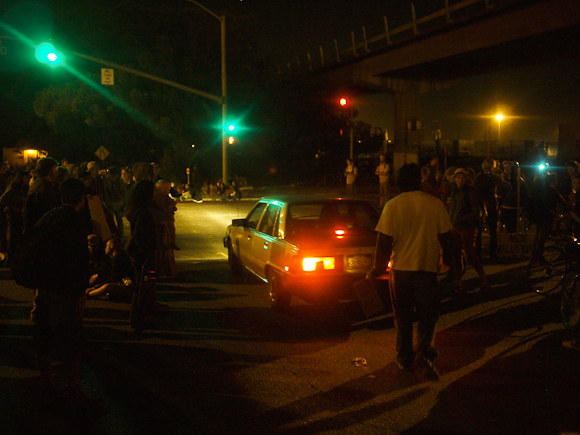
One of the last remaining port workers drives home to the cheers of the crowd: the port is closed for business.
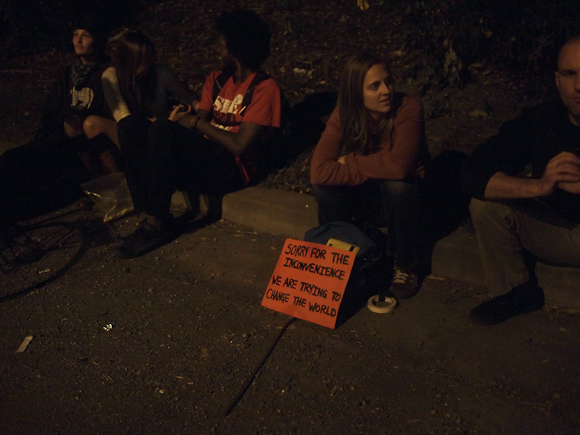
Demonstrators rest after a long, historic day.
education march
Public education feeder march well done! We do need expansion on access to primary and higher education!
A day of defiance in Oakland
Eric Ruder rounds up reports on the general strike and day of action called by Occupy Oakland--with contributions from activists around the country.
November 3, 2011
THE STREETS of Oakland, Calif., echoed with the voices of tens of thousands of people determined to take a stand on November 2 as workers, students, activists and people of all walks of life responded to the call for a general strike by Occupy Oakland.
The determination in Oakland was matched by thousands more around the U.S. who took part in a national day of solidarity action a week after a brutal police assault that turned Oakland's downtown into something close to a war zone--and that nearly took the life of demonstrator Scott Olsen when he was struck in the head by a tear gas canister.
People from around the Bay Area responded to Occupy Oakland's general strike call--teachers stayed away from work, students walked out of classes, and city workers took the day off to join the protests.
The highlight came in the late afternoon with a mass march from the Occupy encampment at Frank Ogawa Plaza--renamed Oscar Grant Plaza--in front of City Hall to the Port of Oakland, the fifth-busiest port in the country. The demonstration shut down the evening shift when longshore workers refused to cross the picket line of some 15,000 people.
"This event is long overdue," said James Curtis, an executive board member of the International Longshore and Warehouse Union (ILWU) Local 10. "Now they have awoken a sleeping tiger."
- - - - - - - - - - - - - - - -
THE STRIKE call brought out solidarity in different forms all over the city. Oakland public school buildings were points of origin for marches of students, teachers and parents that led to the Oakland Board of Education, several banks and City Hall. A feeder march of 700 from Laney Community College shut down a Wells Fargo bank. Hundreds of city workers from Service Employees Union (SEIU) Local 1021 participated in the protest.
Many teachers at high schools, community colleges and the University of California (UC) held teach-ins on the economy and the 99 percent, and the UC system graduate student union, UAW Local 2865, asked its members to use class time to teach about budget cuts.
The streets of Oakland took on a festival-like atmosphere. By the estimates of activists, over the course of the day, some 20,000 people mobilized to Oscar Grant Plaza, the site of the battle a week earlier when the cops moved in against Occupy protesters who had been evicted from the plaza in the early-morning hours.
More than 100 people were arrested October 25, and the police used tear gas, stun grenades, beanbag rounds and rubber bullets against protesters. One of the victims was Scott Olsen, an Iraq war veteran who was struck by a tear gas canister. He remains in the hospital a week later with a skull fracture and brain injury.
But the scene at Oscar Grant Plaza was very different on November 2, and people from across the Bay Area came to the central Occupy site to take part in activities there--before heading to other protests around the city that highlighted a multitude of grievances, from home foreclosures to school closings to attacks on unions to cuts in city services.
"We watch our kids stuck in the prison pipeline with no prospects for jobs or meaningful work," said Betty Olsen-Jones, president of the Oakland Education Association. "We suffer increased class sizes and the imposition of a top-down curriculum, and our kids know that this system thinks the banks and the corporations are more important than they are.
"It's important our students see teachers fighting for their rights. We're making history today. We want a world that's not divided between the 99 percent and the 1 percent."
Dana Blanchard, a teacher in nearby Berkeley was the official spokesperson for the Berkeley Federation of Teachers for the day of action. "Teachers and students have had enough," she said. "Today, we are showing what a united community fightback can look like."
Among the participants during the day of action was a sizeable delegation of Iraq and Afghanistan war veterans who came to show their solidarity with Scott Olsen.
The Alameda County Labor Council called on its membership and staff to support the day of action November 2--and in the evening, it organized a barbeque at Oscar Grant Plaza to feed thousands of people who streamed into the city center after work hours. Meanwhile, Teamsters Local 70 parked its boldly painted 18-wheeler in the middle of the plaza.
- - - - - - - - - - - - - - - -
IN THE late afternoon, several waves of protesters assembled for a march that would set up a mass picket aimed at closing down the city's most important economic asset: the port of Oakland.
At 4 p.m., 2,000 people left, and at 5 p.m., another 4,000 departed. As they stepped off, Earth Amplified and Jennifer Johns performed a send-off serenade called "We Are Worldwide." Minutes later, a delegation made up of workers from UNITE HERE, the Coalition of Black Trade Unionists, United Food and Commercial Workers Local 5, SEIU Local 1021 and others made its way toward the docks.
Demonstrators arrived at the giant port complex and split up to cover the different gates. Occupy San Francisco headed for one, and Oakland activists divided out to cover others. As the 7 p.m. shift change approached, there were thousands of demonstrators on each of the main gates.
After several hours of picketing, the port arbitrator made a ruling that signaled the Oakland docks would be shut down for the night. Jubilant protesters celebrated their victory for the general strike, and most marched back to the downtown area around Oscar Grant Plaza, where the streets echoed with music, chanting and excited discussion.
In marked contrast to their vicious assault last week, the Oakland Police Department (OPD) was practically invisible on November 2--from demonstrations during the day to the march on the docks to the celebrations at night. Oakland Mayor Jean Quan and other city officials have been in full retreat since the police assault a week ago--they no doubt pressed for the police to be on best behavior in the hopes of regaining some shred of legitimacy.
But the cops are also looking for an opening to reassert their authority, in the estimation of activists. They may have taken a hands-off approach in an attempt to demonstrate that "chaos" would ensue without them--even though the day's events were almost entirely peaceful, orderly and festive.
"The OPD's attempt to portray themselves as part of the victimized 99 percent is contradicted by its long history of racist violence and repression of protest," said Todd Chretien, a member of the International Socialist Organization. "Last year, Mayor Quan stood in the streets with Oscar Grant protesters against the OPD, but now she's attempting to play both sides of the fence."
Whatever the case, neither the police nor city officials nor Oakland's business establishment could stop the protesters' show of defiance on the streets of the city and at the gates of the port of Oakland.
"Oakland is the economic engine for the whole Bay Area," Jack Heyman, a retired dockworker and activist in ILWU Local 10, told a Fresno public radio station. "Thousands are marching on the port, which is controlled by the 1 percent, the big capitalists, and by marching on the port and shutting it down, it shows not just Oakland but the whole world the power that the working class has."
Heyman thanked the young longshore workers who didn't show up for work in the morning of November 2, crimping the port's operations from early in the day. "I commend the young people who refused to take jobs this morning," said Heyman. "That's why ship owners had a real difficult time getting together longshore crews.
The specter of workers on strike and a day of mass protest was enough to prompt many of Oakland's largest corporate entities to shut down for the day, adding even more to the numbers in the streets.
"People are joining this cause on a national level, and now it seems more legit," said Gregory Belvin, a 17-year-old student at Skyline High School. "As the 99 percent, we have to speak out against three strikes and minimum-sentencing laws. There's been a war on the youth, a whole generation of youth of color have been lost to the prisons. If we can get those people back, they can help make it a better world."
Powell DeGange, a 26-year-old Oakland resident, expressed joy at being part of a global movement. "We were thrilled that people in Egypt marched in solidarity with Oakland," said DeGange. "We were there for them, now they're standing up for us. We are part of a worldwide movement against the same greed and the same imperialism."
- - - - - - - - - - - - - - - -
ACTIONS IN solidarity with Occupy Oakland took place around the country on November 2.
-- In Portland, Ore., 3,000 people--singing the union anthem "Solidarity Forever"--marched down Broadway Avenue in the heart of Portland's downtown.
"As we walked past a park, activists were waiting there for us, proclaiming with a huge banner that the park had been renamed Aaron Campbell Park, who, like Oscar Grant in Oakland, was an unarmed Black man killed by Portland police a few years ago," said Nicole Bowmer.
The march was led by a contingent of a couple dozen veterans who are members of Veterans for Peace and Iraq Veterans Against the War--which may explain why the Portland police allowed the march to continue, even when some 250 marched across Hawthorne Bridge, one of the main bridges connecting the east and west sides of Portland.
Micaiah Dutt served in the Marines from 2001 to 2009 and was deployed to Iraq four times. Like Scott Olsen, he was radicalized by his experience in the military. "What Scott Olsen experienced by being shot in the head gave the veteran community just a glimpse of what the African American community experiences every day, what the Latino community experiences. That's why we called everyone out today to say this has to stop!"
-- In New York City, more than 1,000 people marched from the Occupy Wall Street encampment at Liberty Plaza to NYPD headquarters, chanting, "Oakland, NYC, stop police brutality!"
"This building looks like an administration building," a member of the People of Color Committee told the rally via the people's mic. "To the 99 percent who are people of color, this building is a tomb. Here lies Sean Bell, here lies Patrick Dorismond, here lies Alberta Spruill. We honor the West Coast and Bay Area by saying 'Presenté' for Oscar Grant."
Marine Sgt. Shamar Thomas, famous for his rant against cops in Times Square that went viral in a YouTube video, told the rally, "You have a right to be here. We're here to protect you. I love you."
Thomas was part of a contingent of veterans participating in the march. Iraq Veterans Against the War (IVAW) member Andrew Johnson explained that he supported Occupy Wall Street because "the war economy is part of the reason for the mess we're in."
Earlier in the day, about 40 members of IVAW and Veterans for Peace marched from the Vietnam Veterans memorial to the New York Stock Exchange, and then to Liberty Plaza.
"I've been one of those people saying something is wrong, something's got to give," said IVAW member Grant Bailey, who was on the march and has been participating in Occupy for weeks now. "I came here to check this out and then started learning a lot more about what those somethings are."
-- In Seattle, students at the University of Washington and Seattle Central Community College held speakouts on their respective campuses, and later took part in a march to Chase Bank, where five people handcuffed themselves together inside the bank. About 100 protesters waited outside while the cops struggled to figure out how to cut them out. Chants of "The banks got bailed out, we got sold out" and "We are the 99 percent" kept spirits up.
As dozens of police arrived and tried to arrest the five, protesters outside attempted to block their access. Chaos ensued. Cops in bikes started pushing aggressively--and demonstrators pushed back, chanting "We are all Scott Olsen." One cop started pepper spraying the crowd at point-blank range. The crowd backed up, but did not disintegrate.
After protesters sat down in front of the paddy wagon, cops started to grab individual demonstrators to try and arrest them. The crowd also grabbed them and pulled them away from cops so they couldn't be arrested. For a solid hour, the crowd controlled Broadway, which is the main drag in Capitol Hill. The cops tried to push us down the street. We regrouped, locked arms and pushed back the bike cops.
Eventually, the protesters shifted their focus to a 1,000-strong protest of Chase Bank CEO Jamie Dimon, who was speaking at an event sponsored by the UW Foster School of Business.
-- In Philadelphia, several hundred people from Occupy Philly marched through the streets chanting "We are Oakland, I am Scott Olsen" and "The banks got bailed out, we got sold out."
When the march ended, some took part in a sit-in inside Comcast's headquarters while the remaining protesters continued chants outside in solidarity. The sit-in was organized to protest Comcast's failure to pay property and other taxes. Nine protesters were arrested, which led to a solidarity action outside Philadelphia police headquarters.
-- In Burlington, Vt., workers and students converged on the campus of the University of Vermont (UVM) to show solidarity with members of United Academics Local 3203 who are fighting against austerity measures at UVM. Mary Lou Kete, an English professor from the University said she was dismayed at the "profit mentality" of the school, and described the administration as "bloated and ineffective."
The crowd of 300 then marched to join Burlington's five-day-old occupation of City Hall Park. Many speakers at the park spoke in support of Occupy Oakland and against police violence. "I beg you," said Marni Faye Salerno, a Burlington resident, "when you see something unjust, or someone acting unjust, fight back!" The day was a fantastic demonstration of unity and passion about the many issues facing the 99 percent.
-- In Rochester, N.Y., 350 people marched from Washington Square Park to City Hall to demand that all charges be dropped against the 32 people arrested Friday evening when the mayor ordered our encampment be disbanded.
Labor unions turned out in big numbers. Sheet metal workers, members of the health care workers union 1199SEIU, state social workers and teachers wore union t-shirts and marched alongside people from all walks of life.
Earlier that day, the New York Civil Liberties Union sent a letter to Mayor Tom Richards giving full support to Occupy Rochester's demand that we have a right to remain in the park overnight on free speech grounds. Earlier in the week, Richards invited Occupy activists to meet even as he continued to stonewall our demands.
Following today's march and our largest general assembly yet, Occupy Rochester decided again to challenge the City and assert our right to set up a permanent encampment. As this report was written, 60 people were still occupying the park, banging drums, holding meetings and waiting for the coming showdown with the city.
-- In Gainesville, Fla., around 80 students and community members rallied at the University of Florida (UF) campus for the debut event of Occupy UF today as part of the national day of action. Unionized graduate student members as well as members of the faculty union addressed the crowd.
One of them, Zoharrah Simmons, a professor and veteran of the civil rights movement, spoke about the parallels between the Occupy movement and the struggles in which she participated some 50 years ago. "If Martin Luther King were with us still today, he would be a part of the Occupy movement," she said. "It's up to us to pick up his dream, for a poor people's movement, and run with it."
After an hour or so of an open mic that allowed all participants to speak, the group marched through the notoriously pro-corporate business school, chanting loudly. The marchers then proceeded towards downtown, passing the district attorney's office and joining up with the ongoing encampment in downtown Gainesville, to co-host a General Assembly with Occupy Gainesville, which went on to unanimously endorse a November 5 rally and march in solidarity with the New York Central Labor Council's call for a workers march against the 1 percent.
-- In Greensboro, N.C., about 75 people gathered at downtown Governmental Plaza for a rally and short march to the Occupy Greensboro encampment at the YWCA where a number of speakers addressed the crowd.
Mark Dimenstein of the American Postal Workers Union spoke of the struggle against budget cuts at the post office; Lewis Pitts, an activist who helped represent the victims of the Greensboro Massace of 1979, spoke about the history of that struggle; and a Bay Area resident gave the crowd updates from Oakland.
Along the march route, protesters chanted, "From Oakland to NC, Occupy will be free!" and "I am Scott Olsen, I am Oscar Grant!" The march ended at the YWCA encampment where protesters attended a General Assembly meeting, many of them for the first time. Occupy Greensboro will soon be clearing its encampment from the YWCA and hopefully moving to a new location, but activists plan to continue organizing wherever they end up.
-- In Houston, about 45 people marched through downtown from the Occupy Houston camp to Houston Police Department (HPD) headquarters and then on to the courthouse and the sheriff's department. The march was very spirited, with the most popular chants being "HPD! HPD! Keep your hands off of me!" "Houston is Oakland!" and "We are Scott Olsen!"
- - - - - - - - - - - - - - - - -
Post general strike provocateurs
http://www.indybay.org/newsitems/2011/11/03/18697018.php?show_comments=…
Last night's Traveller action was a betrayal of trust. It was Riot Porn. Not Revolution. A masturbational fantasy, it was a gift to power.
Like many people I feel like I have been used as some kind of cover or shield for this action. I went to the Plaza to participate in a day of actions with the main goal of a general strike, but mostly to demonstrated solidarity and to share.
The strike was achieved, a monumental milestone which gave the Occupy Oakland an enormous amount of kudos and capital within the community at large and the world. To cash-in the success so quick, indeed, to get very quickly in-debted and over-drawn with an action, that in itself is really worthy, but uses the shield of every marginalized and needy person in Oakland is pretty naive at best and basically really very selfish.
When the 40 000 people came to Occupy Oakland at the Plaza, and then later the port, they took ownership of Occupy Oakland. They bought in. They took it away and felt like it was theirs. Once they get home, they find its a bait and switch, as normal, they have been had. This time by mostly white radicals - I wont give them credit for being even anarchist - who are prepared to risk everything the good people of Oakland have put into the Occupy campaign.
So, maybe yesterdays attendees should of been more warey, more skeptical, they should of read the fine print of the contract, read between the lines.
If the action did not accompany property damage, vandalism and anonymous agent provocateurs it may have been a success and the gamble may have worked. But instead, I watched some of the live streams - video and text - and it looked more like Riot PORN. Not a revolutionary act.
The Occupy phenomena is now much bigger than the camp downtown. Its a dream. Now its an American Dream
I'd suggest you look at the COP15, the UK Climate Justice movement between 2007-2009 and further back, the Genoa G8, and the Gladio networks Strategy of Tension to see how much agent provocateurs are a very real and organic part of the activist scene.
http://www.indymedia.ie/article/75401
http://www.guardian.co.uk/world/2008/jul/17/italy.g8
http://en.wikipedia.org/wiki/Strategy_of_tension
http://www.indymedia.org.uk/en/2011/01/472363.html
Anonymous concealed direct action not only provides the perfect Trojan Horse for provocateurs, its also a shield for stupidity and criminal activity. If you want no police, then you have to maintain the peace yourself. That's how the Spanish Revolution did it, until it was undermined by liberals and communists and then smashed by fascists (sound familiar?)
Look what happened to the revolutionary potential around the UK Phone Hacking Scandal involving the police, highest levels of government and News International (Murdochs UK division i.e. News of the World etc). There where the ingredients for bring down the House of Murdoch, the Conservative Government etc, the entire Establishment.
Instead, a blacks mans murder by police and the clumsy cover-up triggered a degeneration into riots and wide scale looting, and an almost race war. All this was simply a gift to power. Suddenly the revolutionary moment became a law and order moment and the Establishment stepped in. There is potential for a very similar dynamic to occur in Oakland.
There are very real contradictions around race and gentrification within the Occupy camp and wider movement and these tensions will be used as a wedge.
Next time you fancy some RIOT PORN, consider the folks in wheelchairs, the undocumented workers, the private non-union employees that risked everything by associating with Occupy Oakland.
Occupy Oakland is not the campers anymore. It's the communities.
If you want to be tough and go it alone, leave the camp and don't come back. That's what most of the anarchist movements in Europe do, they deliberately isolate themselves from the big tent, they sure as hell dont use it as base camp.
Winter is coming, Occupy needs friends, not enemies. Needs to be known, not anonymous. Creative not destructive. Otherwise you are just basically marionettes for the ultra-right, playing in a Strategy of Tension puppet show.
Good Marxmail comment on black bloc provocations
the working class isn't going to learn anything from a block of ninja-looking anarchists *off by themselves* getting into a riot with the cops. It's a non-starter. Why the fucking bonfire in the middle of the street last night? Why? Trying win over the 'masses'? What's the "lesson" here? (I would assume don't wear black at night as you'll get run over, then arrested).
I think the anarchists, that is this particular subset of them, don't give a damn about the masses, the people, the OWS or anything, despite their rationalization for occupying this building. I think we all have to condemn the police for their attacks and that should go without saying...but, pray tell, where the hell did the molotov cocktail come from? 'just in case'? what was that supposed to do..."drive the cops back"? Indeed, it's "riot porn" plain and simple.
The anarchists, who *act* as provocateurs because they make the cops seem to be needed to the 99% of the residents of Oakland who are not at the Plaza last night, wanted a riot. It's clear from talking to almost any of them today. This is not how to win over the masses and it goes to why the anarchists are the WORST of the so-called "Vanguardists" they claim to distain: total contempt for the mass movement, total individualistic, unorganized, chaotic immaturity. The Spanish Anarchists, who were REAL anarchists, and not the stuffed black attired wind-up dolls with "A"s on their backs, would take these guys through the ringer. Or worse. The anarchists in Spain *respected* both the mass movement, rejected vanguardist subsitutionism and respected democratic *voted on* positions when the majority decided to do something...or not to do it. Oh, yeah, our "anarchists" don't like "democracy" and certainly hate votes. We've seen that time and again in UCB for the last two years. Gets in the way of their vaunted a-historical academic concept of "autonomy". OK, that's my cathartic outburst as these poisers.
The fact is that the Oakland Occupy General Assembly never voted to occupy that building. It was never poised to the people at the Plaza that this should be done and thus it wasn't the general will of the GA. The Direct Action subcommittee never moved to raise this during Tuesday's night discussion. The anarchists were doing it "for the movement", you know, of the coming "winter", they say. Of course the were, that's why they staged what any small group Direct Action usually comes off as: a disaster and a
*provocation*. Having say, thousands of the Occupiers do this, after a vote, after a discussion where it's decided democratically (I know, that term again, call me old school) is one thing. Having a 150 of the ninjas do it, something else again.
The "autonomy" concept is a god-send to the ruling class because it will forever keep any movement from actually acting as a movement, united, yes, "disciplined" in objectives, and powerful. It prevents the movement from ever making united decisions. It is ultimately the most undemocratic form of organizing, at least as it's been expressed in this incident. I so respect the decision of the general OWS that has encouraged this sort of thinking, but I think it's shown to be dead wrong.
Someone pointed out that this could only happen as an adjunct to a mass-movement as these jokers wouldn't dare do it without the political cover of the actual people who went out on strike, marched and so. They want to go out and do this on their own, and NOT associate it with the Strike and the other occupy actions, by all means.
I will repeat, the overwhelming majority of the participants AND organizers of the Occupy movement reject this violence, despite the attacks by the cops and vandalism as it doesn't reflect any segment of society fighting back against the 1%. These black-clad clowns can't 'teach' anyone anything and we don't need them to bring "lessons" to the masses...we can do that on our own thankyouverymuch through marching, striking and elevating the confrontation with capitalism *politically*. Everything else will come naturally wthout these ultra-vangardists telling eveyone how to behave.
Occupy Oakland Shuts Port as Unions Hustle to Keep Up
A massive “day of action” in Oakland closed businesses in the city’s downtown core and halted traffic at the nation’s fifth-largest port. Unions hustled to rally members, building a healthy response for the first occupy action where success required other organizations to mobilize. Photo: Adam Hefty.
A massive “day of action” in Oakland closed businesses in the city’s downtown core and halted traffic at the nation’s fifth-largest port.
About 7,000 marchers took part, mainly occupiers and other folks marginalized by an out-of-whack economic system and drawn to participate with the rest of the 99 percent.
Union members—Oakland teachers, SEIU home health care aides and service workers, public sector workers, NUHW nurses, CWA Verizon workers, Teamster drivers, UAW grad students, and Laborers—came out in smaller but noticeable numbers.
The unions had just a week to activate members in response to the call from Occupy Oakland to walk out, in protest of a police raid on the encampment last week that left protester and Iraq war vet Scott Olsen hospitalized with a fractured skull.
Although the demonstration was far short of the general strike called for by the occupiers, the response was healthy for the first action where success required other organizations to mobilize.
“My union called for member participation,” said David Norris, a fourth-grade teacher at Acorn Woodland in Oakland, one of about 300 teachers to skip work yesterday. “Teachers are under attack and that means our students are under attack.” The Oakland Education Association urged members to join the protest after school.
SEIU Local 1021, the mammoth public sector union, dispatched member organizers to its worksites to motivate members. It sent out robocalls encouraging members to participate. At the Laborers’ hiring halls, the union directed members toward the mobilization if there was no work for them that day.
“I realize that the reason I don’t always have work, like today, is because the banks ran us into the ground,” said Laborer Kevin Smith. “I’m unemployed, frustrated, and mad like everyone should be if you’re in the bottom of the 99 percent.”
Unions have been helping pay for toilets, food, hay for the muddy encampment, and bottled water. The Communications Workers paid for Occupy Oakland placards and the Alameda Central Labor Council fed occupiers on the day of action.
Shutting Banks, Sharing Stories
Cultural, political, and community groups like Causa Justa/Just Cause and Alliance of Californians for Community Empowerment led 1,000 on a march snaking between Bank of America, Chase, and Wells Fargo. “We were planning to occupy these banks but when they saw the size of the wave heading their way they locked themselves in,” said Nell Myhand, a member of Just Cause.
The bank protesters proceeded to furnish the street with a couch and other furniture where they sat and shared stories about home loss and being taken advantage of by predatory lending and toxic home loans.
“To me this looks like a mass movement and as unionists—and part of the 99 percent—we must support it,” said Herb Klar, a social worker in the Kaiser Permanente hospital chain and an NUHW member.
The sunny day started with large crowds of activists that were as diverse as they were energetic. From kids to old folks, the camp was bustling with activity as people made signs, prepared meals, engaged in political discussions, and danced to a DJ.
The occupiers were joined by 300 parents with a children’s brigade, 200 students from UC Berkeley, and an anti-capitalist contingent that vandalized a Whole Foods store and broke bank windows.
As the hours passed the encampment swelled. By 3 p.m. the “Share Your Story” tent was covered with hundreds of stories ranging from the student deep in debt to teachers facing the hardships of teaching in overcrowded classrooms with gutted budgets to folks facing foreclosure.
Blockades at the Port
Longshore workers with ILWU Local 10 had announced earlier in the week that if Occupy Oakland put down pickets they would honor them.
Because of contract terms, the union asked members to go to work and join the occupiers in the evening. But about 40 longshoremen showed up to the hall in the morning and refused to take work, effectively slowing work at the port. Non-union port truck drivers were backed up for miles.
The occupiers shut the port completely when they converged there at 7 p.m. The march leading to the port seemed to stretch as far as the eye could see, with dancing, chanting, and bikers intermingling. Marching bands and portable sound systems helped activists keep a steady pace.
Groups of about 200-300 stopped at each port gate and set up blockades. Protestors climbed train light towers, hung banners, and physically blocked port trucks from entering.
The scene was electric as protestors realized that they indeed had the numbers needed to shut it down.
The port asked protesters to let workers leave to go home, and ILWU officials said night-shift workers wouldn’t try to make it through the barricades.
As the night wore on, a sort of block party broke out, with younger protesters blockading both sides of the street with burning trash bins. When they broke into a building for an impromptu party, police arrested about 40.
“As long as we can steer away from the street fighting and not get too narrow with our demands, this movement will keep going,” said Peter Olney of ILWU. “The occupy movement represents a reawakening. We’re just trying to keep up here.”